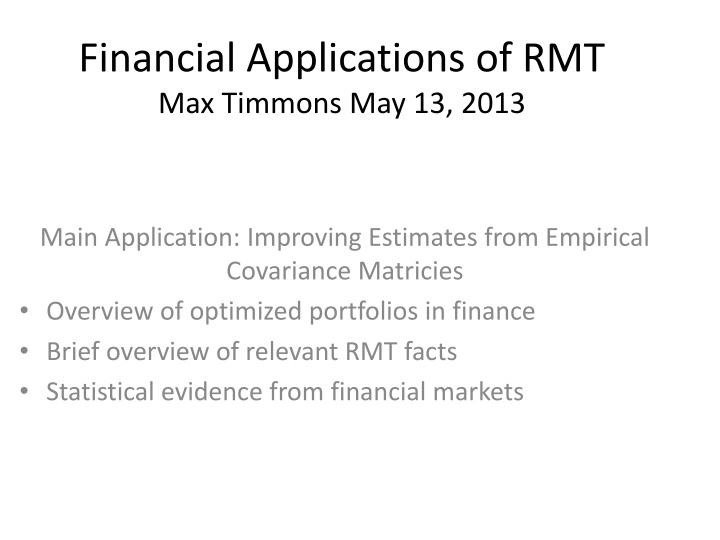
Applications of Random Matrix Theory in Financial Portfolio Optimization
Explore how Random Matrix Theory (RMT) is applied in financial portfolio optimization to distinguish true covariance matrices from empirical ones, with statistical evidence from financial markets supporting the theory. Discover the key principles of RMT and how it helps in maximizing returns and minimizing risks in modern portfolio theory.
Download Presentation

Please find below an Image/Link to download the presentation.
The content on the website is provided AS IS for your information and personal use only. It may not be sold, licensed, or shared on other websites without obtaining consent from the author. If you encounter any issues during the download, it is possible that the publisher has removed the file from their server.
You are allowed to download the files provided on this website for personal or commercial use, subject to the condition that they are used lawfully. All files are the property of their respective owners.
The content on the website is provided AS IS for your information and personal use only. It may not be sold, licensed, or shared on other websites without obtaining consent from the author.
E N D
Presentation Transcript
Financial Applications of RMT Max Timmons May 13, 2013 Main Application: Improving Estimates from Empirical Covariance Matricies Overview of optimized portfolios in finance Brief overview of relevant RMT facts Statistical evidence from financial markets
Overview: Modern Portfolio Theory Classic goal is to maximize return and minimize return Consider a portfolio P of N assets where piis the amount of capital invested in asset i and Riis the expected return of asset i Expected return is RP= Ni=1piRi 2P= Ni,j=1piCijpj where C is the covariance matrix Optimal portfolio minimizes 2P for a given RPand involves inverting C. This places a large weight on the eigenvectors of C with the smallest eigenvalues. Want to distinguish the true covariance matrix from statistical due in the empirical covariance matrix as sample size is not large compared to size of matrix Empirical covariance matrix Cij=1/T* Tt=1 xi(t) xj(t) where xi(t) is the price changes
Relevant RMT Facts If xi(t) are independent, identical distributed, random variables then we have a Wishart matrix or Laguerre ensemble (i.e. all assets have uncorrelated returns) If Q=T/N 1 is fixed than as N , T the Marcenko-Pastur law gives the exact distribution of eigenvalues In particular maxmin= 2(1+1/Q 2sqrt(1/Q))
Evidence from Financial Markets Is the independence of all assets a good assumption? The Marcenko-Pastur law predicts the distribution of small eigenvalues pretty well but there are much larger eigenvalues than predicted (from NY and Tokyo stock markets) The largest eigenvalue roughly corresponds to the overall performance of the market Other large eigenvalues correspond to specific industries Looking at the discrepancies between the Marcenko- Pastur prediction and the data provides actual information on covariance that is not due to noise
References Laloux, L. Cizeau, P. Potters, M. Bouchaud, J. Random Matrix Theory and Financial Correlations. Int. J. Theor. Appl. Finan. 03, 391 (2000) Utsugi, A. Ino, K. Oshikawa, M. Random matrix theory analysis of cross correlations in financial markets. Physical Review E 70, 026110 (2004). Plerou, V et al. Random matrix approach to cross correlations in financial data. Phys. Rev. E 65, 066126 (2002)






















